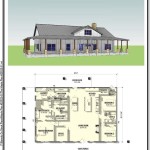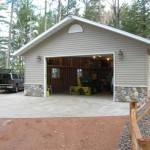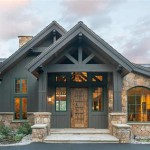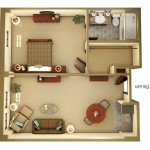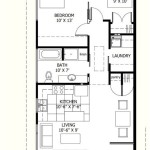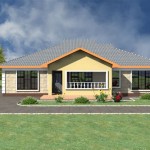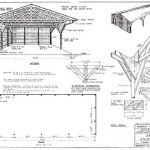Small Barndominium Plans With RV Garage: Combining Compact Living and Recreational Vehicle Storage
The barndominium, a portmanteau of "barn" and "condominium," represents a growing trend in residential architecture. This design philosophy repurposes or mimics the aesthetic of agricultural buildings, offering open floor plans, high ceilings, and durable construction. The incorporation of an RV garage expands the utility of a barndominium, catering to individuals and families who embrace recreational travel and require secure, climate-controlled storage for their RV. Small barndominium plans with RV garages present a compelling option for those seeking a simplified lifestyle without sacrificing the ability to explore the open road.
This convergence of minimalist living and recreational accessibility necessitates careful planning. The integration of an RV garage into a smaller barndominium design requires consideration of space optimization, structural integrity, and aesthetic harmony. While larger barndominiums may easily accommodate an attached RV garage, constrained floor plans demand innovative solutions to ensure both living space and RV storage are adequately addressed.
Key Considerations for Small Barndominium Designs with RV Garages
Developing a successful small barndominium plan with an RV garage involves a multi-faceted approach. Several critical factors influence the overall design, functionality, and long-term suitability of the structure. These factors include space allocation, structural design, aesthetic integration, and adherence to local building codes.
Space Allocation: The primary challenge lies in efficiently allocating space between the living area and the RV garage within a limited footprint. This necessitates a thorough assessment of individual needs and preferences. The size of the RV will directly dictate the dimensions of the garage, influencing the remaining space available for living areas. Prioritizing essential amenities and embracing open-concept design principles are crucial for maximizing the perceived and actual space within the living quarters. Loft areas can be strategically incorporated to increase sleeping or storage capacity without significantly expanding the overall footprint. Furthermore, outdoor living spaces, such as patios or decks, can extend the usable living area, particularly during favorable weather conditions.
Structural Design: Barndominiums are typically constructed using post-frame construction techniques, characterized by widely spaced vertical columns that support the roof and walls. This method offers inherent structural strength and allows for large, open interior spaces. However, integrating an RV garage requires adjustments to the standard post-frame design. The garage door opening, in particular, demands substantial reinforcement to withstand wind loads and maintain structural integrity. Headers, or horizontal beams, spanning the garage door opening must be appropriately sized to carry the weight of the roof and any superimposed loads. The foundation must also be designed to accommodate the weight of both the structure and the RV, ensuring long-term stability and preventing settling. Foundation options include concrete slabs, pier and beam systems, and stem walls, each offering varying degrees of cost and complexity.
Aesthetic Integration: Maintaining a cohesive aesthetic between the living area and the RV garage is crucial for creating a visually appealing and harmonious structure. The RV garage should not appear as an afterthought, but rather as an integral part of the overall design. Coordinating the exterior cladding, roofing materials, and window styles between the barndominium and the garage helps to create a unified appearance. Consider incorporating design elements that visually soften the transition between the living area and the garage, such as landscaping, trellises, or decorative screens. The placement of the RV garage relative to the main living area can also influence the overall aesthetic. Attaching the garage to the side or rear of the barndominium may minimize its visual impact, while integrating it into the front facade can create a more prominent and purposeful design.
RV Garage Dimensions and Features
The dimensions of the RV garage are primarily determined by the size of the recreational vehicle it is intended to house. Standard RVs range in length from 20 feet to over 40 feet, with widths typically around 8 to 8.5 feet. The height of the RV also needs to be considered, as well as sufficient clearance for opening roof-mounted accessories or antennas. A minimum garage door height of 12 feet is generally recommended for accommodating most RVs, with taller doors necessary for larger models.
Beyond basic dimensions, several features can enhance the functionality and convenience of the RV garage. These may include:
- Electrical Outlets: Multiple electrical outlets are essential for powering RV appliances, tools, and lighting within the garage. A dedicated 50-amp outlet is typically required for plugging in the RV's shore power cord, allowing for battery charging and operation of onboard systems.
- Water Hookups: A water spigot inside the garage allows for easy filling of the RV's water tank and washing the vehicle. A floor drain can also be installed to facilitate cleanup.
- Waste Disposal: A septic hookup, also known as a sewer cleanout, allows for convenient dumping of the RV's black and gray water tanks, eliminating the need to transport waste to a separate disposal station.
- Ventilation: Adequate ventilation is crucial for preventing the buildup of moisture and fumes within the garage. Exhaust fans or natural ventilation systems can help to maintain air quality.
- Insulation and Climate Control: Insulating the RV garage can help to regulate temperature and humidity, protecting the RV from extreme weather conditions. Heating and cooling systems can be installed for optimal climate control.
- Storage Solutions: Incorporating storage solutions, such as shelving, cabinets, or overhead racks, can help to keep the garage organized and clutter-free.
Navigating Building Codes and Regulations
Constructing a barndominium with an RV garage requires adherence to local building codes and regulations. These codes vary depending on the jurisdiction and may address aspects such as structural requirements, fire safety, energy efficiency, and zoning restrictions. It is imperative to consult with local building officials or a qualified architect or engineer to ensure compliance with all applicable codes.
Zoning regulations may dictate the permissible uses of land, the size and placement of structures, and the minimum setbacks from property lines. Some jurisdictions may have specific restrictions on the construction of barndominiums or the storage of recreational vehicles. Obtaining the necessary permits before commencing construction is crucial to avoid potential fines or delays.
Fire safety is a paramount concern in any residential structure, particularly in barndominiums with attached garages. Fire-resistant construction materials, such as concrete or metal siding, are recommended for the garage walls and roof. Smoke detectors and fire extinguishers should be installed throughout the barndominium, and a fire-rated door should separate the living area from the garage. Properly installed electrical wiring and plumbing systems are also essential for preventing fires and other hazards.
Energy efficiency is another important consideration, particularly in regions with extreme temperatures. Insulating the walls, roof, and floor can help to reduce energy consumption and lower utility bills. Energy-efficient windows and doors can also contribute to improved thermal performance. Consider incorporating renewable energy sources, such as solar panels, to further reduce the environmental impact of the barndominium.
The successful integration of an RV garage into a small barndominium design requires a meticulous approach, considering spatial constraints, structural integrity, aesthetic considerations, and regulatory compliance. Thoughtful planning and collaboration with experienced professionals are essential for creating a functional, aesthetically pleasing, and code-compliant living space that caters to the unique needs of RV enthusiasts.

Plan 280185jwd Modern Barndominium Style House With Rv Garage 1273 Sq Ft 1673

Rv Garage Barndominium 2 Bedroom 1 500 Sq Ft Ingreen White With Carport Story Metal Barndo Home Kit

Barndominium With Wraparound Porch And Garage Plans Blog Floorplans Com

Herschel 2 Bedroom Rv Garage Barndominium Style House Plan 1372

House Plan Of The Week Barndominium With An Rv Garage

Barndominium Style Carriage House W Rv Garage Sand Springs

House Plan Of The Week Barndominium With An Rv Garage

Rv Garage Plans With Incredible Storage Blog Dreamhomesource Com

Mesquite Double Rv Garage Model House Plans Barndominium Floor Barn Homes

4 Car Garage With Rv Barndominium Style House Plan 6604

